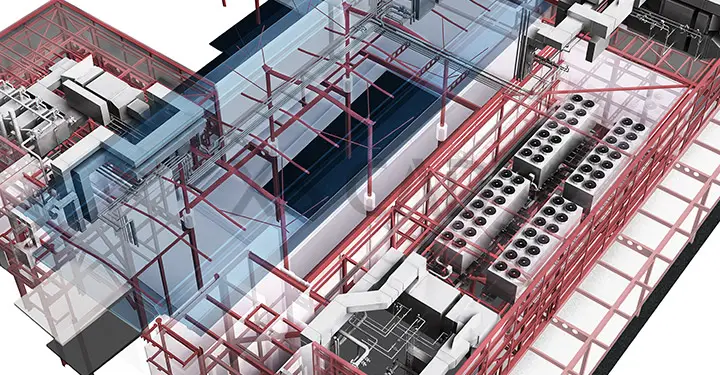Our Articles

3 Ways to Avoid MEP BIM Design & Coordination Scope Overlaps
Construction and the MEP (mechanical, electrical, plumbing) industry, also known as the M&E industry, owes a debt to the technological advance we know as Building Information Modelling (BIM). The BIM methodology has introduced several benefits to the design and build process in terms of streamlining workflow, collaboration, cutting costs and completing projects on time. Eminently useful, MEP coordination facilitated by BIM, or BIM coordination, is an integral part of pre-construction planning, which helps maintain a building’s life cycle. However, it is imperative that BIM coordination is handled by experienced professionals with sound technical knowledge of engineering design services.
The successful adoption of BIM practices depends largely on the level of interaction between the MEP (M&E) design consultant and the contractor. Prior to the era of BIM, responsibilities, such as conceptual design, detailed 3D modelling, and 3D building services coordination, were handled by separate parties. Adopting BIM practices can lead to a serious scope overlap between design consultants and contractors, particularly if the BIM workflows are not clarified during the planning phase.
Tasks, including creating MEP BIM models, carrying out 3D M&E (MEP) BIM coordination and extracting M&E (MEP) coordinated drawings from 3D models, can be injected into the scope of multiple parties: MEP design consultants, contractors and other trade-specific subcontractors. For instance, though carrying out 3D BIM coordination is a part of the contractor’s role, the design consultant may also spend some of his time and effort making the model clash-free with respect to the architectural and structural models. Similarly, the MEP contracting team will have to change the BIM model provided by the design consultant if it does not meet the contractor’s requirements with regards to procurement changes, lagging allowances and installation efficiency.
Taken together, such issues in M&E design services pose serious challenges for BIM projects. The fact that the contractor has to repeat the BIM modelling task (in addition to extracting the MEP coordinated drawings) and that the design consultant has to carry out services coordination (which is actually the contractor’s task) are some key areas of scope overlap. This leads to effort duplication and additional cost that finally affects project schedules. The whole point in employing MEP (M&E) BIM methodologies is to reduce duplication, increase efficiency and improve interdisciplinary coordination. Such overlaps in responsibilities defeat the very goal of using BIM practices.
To avoid such MEP design and coordination overlaps, there are three possible routes that can be taken:
1. Both MEP design consultant and MEP coordination team strictly focus on their core responsibilities
2. The design consultant creates 2D MEP designs and hands it over to the MEP contractor.
3. The MEP design consultant works with a specialist 3D BIM coordination and support firm.
Once the route is selected, a contact list (BIM Participation Log) can be created, listing each subcontractor involved for:

These subcontractors should ideally have been involved and have thorough knowledge of BIM coordination. They should also preferably be familiar with some of the following software:
In case the subcontractor is hiring a third party to work on the detailing and coordination, the scope of the work must be precisely determined. At this point, work on the coordination model can start and a BIM schedule can be created, so that the process can be as follows:
What is a BIM kick-off meeting?
Typically, this is a meeting held before coordination begins, involving all stakeholders participating in BIM coordination, including the general contracting team. They discuss the guidelines, instructions, specifications, standards and the BIM attachment contract. Upload instructions and guidelines for file naming, folder structures, etc. are communicated. In addition to helping all stakeholders to work together seamlessly, the general contractor can ably support the BIM coordinator.
Ideally, the specialist BIM coordination firm is able to partner with MEP designers, consultants, contractors, fabricators, manufacturers and installers to provide BIM models, MEP drawings, undertaking building services coordination and other engineering design services support, taking into account regional standards and building codes for HVAC, mechanical, pipe work, plumbing, electrical and fire systems.
XS CAD has valuable experience providing MEP 3D BIM coordination and coordinated drawings for MEP contractors. Our range of services for building engineering firms, such as consultants and contractors across the world, include MEP drafting, MEP modelling, 3D M&E (MEP) coordination, designing MEP systems and fire design engineering. We create these models and drawings by using Revit MEP, AutoCAD MEP and BIM 360 Design for cloud collaboration.

